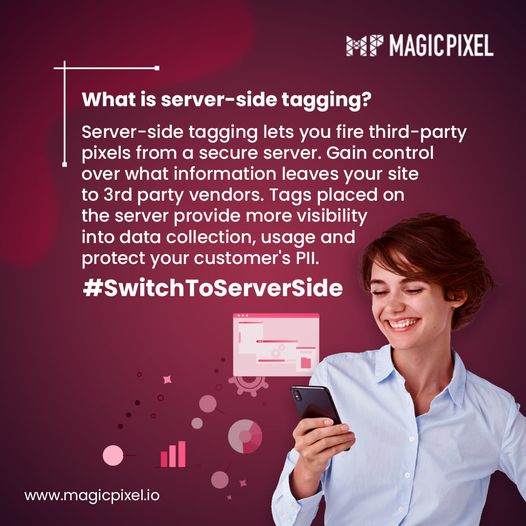Data has been driving businesses of every domain since anyone can remember. When data is more powerful than ever, it is important that marketers make the most of it at times like these. Among the categories of data that have risen to the absolute top is first-partydata collection and usage via server-side tagging.
However, being involved with
marketing technologies can feel like an overwhelming task in the current
climate. It feels as if the internet landscape is suddenly changing and not in
a way that professionals in the domain would really want and a transition could
be seen sooner rather than later.
The transition from third-party cookies to a first-party data strategy
Third-party cookies are slowly
running out of ground to back up. There has been an outcry over data collected
through such methods, and almost all entities associated with it have been
critical of it. Browsers have implemented tracking prevention protocols,
countries are legislating robust data privacy laws, and the general users have
taken towards using adblockers and anti-tracking apps and plugins.
It meant that marketers were
experimenting with alternate data collection strategies via the method known as
server-side tagging. This alternate method gave more control over
sensitive information being passed around as the focus was based on first-party
data.
How can marketers make use of server-side tags?
As the name suggests, server-side tagging involves collecting information from the user, passing it on to a
secure server that controls the flow of sensitive data, and forwarding the
required data to ad vendors requesting the same.
But how exactly should you as a marketer
make use of tags deployed from the server?
·
Enhance first-party data collection
First-part data is valuable, and it is worth repeating the same, but if your
site’s performance is not up to the mark, there might be no scope to collect
such data. Too many tags on the client-side hampers site performance and
affects user experience negatively.
Once you switch to the
server-side, the calls to the client-side tags are reduced, and one single call
is made to the server-based API. Not only is that helpful in improving
performance, but you are also now able to collect data on a more 1:1 basis,
meaning that the data you collect is only yours to use.
·
Optimizing ad spend
As a marketer, you are held
accountable for every bit of ad spend, and therefore it becomes increasingly
vital to know what channels are producing the best results. Server-side tags
allow you to gain clearer insights into which channels provide the best
return-on-ad-spend (RoaS) as HTTP endpoints
responsible for customer data tracking.
When you know the best channels
for RoaS, you can focus more on them and try to find solutions for the other
channels instead of burning your ad spend. Tag management tools such as
Magic Pixel help provide such insights, and you can try to make use of such tools and
services.
Media tags: How can you publish it for the first time?
Media tags or pixels are powerful
tools when it comes to data collection. Implementing some of these from top
social media sites such as Facebook or LinkedIn can often do wonders for
getting unique insights on audience data. However, if you are trying to implement
them for the first time and that too via server-side tagging, it can be
a bit confusing on how to go through the whole process.
While the easy way out of this
would be to make use of a tag management tool such as MagicPixel or
Google Tag Manager, there are also a few simple steps to follow if you want to
do it by yourself.
1. Create a provider
The first and foremost step is to
select a provider from a list of available providers such as Facebook or
LinkedIn. Once selected, add the media tags, which allow for creating the pixel
or tag ID of the respective provider. Then you shall have to save it, and the
first step is done.
2. Create the qualification criteria
The next step involves selecting
the qualification criteria of the data elements relevant to the site or tag.
Select the ‘current page URL’ while adding data elements. This step is
responsible for defining the conditions for firing the media tag.
3. Creating the tag
The creation of the media tag
binds together data elements, providers, and qualification criteria, as
mentioned above. After adding and naming a tag, define the tag query
parameters, provider attributes, and tag attributes. Finally, validate
everything and then save.
These steps should help you get a
fair idea of how to proceed when it comes to publishing your first media tag
and set you on the journey towards seamless data collection.
Server-side tagging will become more prevalent over time.
As we are currently seeing in the
Mar-Tech space, marketers are slowly running out of ground to bank on tried and
tested solutions from the last 5-10 years. As a result, the embrace towards server-side
tagging has been slow, and for valid reasons.
It’s not as easy to implement and
maintain as client-side tagging, and there’s lesser scope for unbridled data
collection practices. However, they have to get on the bandwagon before they
are forced to do so due to external factors such a privacy concerns, legal
obligations, or disbanding of popular data collection methods.
With such challenges facing
marketers, tag management tools such as MagicPixel has designed
solutions that cater to all of their needs. Be it server-side tagging or
publishing media tags for the first time, and there is ample support on the
platform to guide marketers across this new terrain of the internet.
If you are a marketer struggling
to grip and implement the concept of server-side tags and publishing media
tags, we have you covered. Now, you can book a short demo with us, and we will
get back to you at the earliest.

Comments
Post a Comment